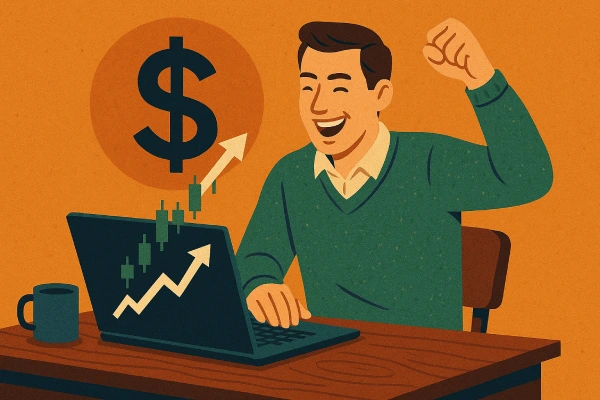How to Turn Breaking News into Big Profits: Real Trading Strategies
How to Turn Breaking News into Big Profits: Real Trading Strategies
"Unlock the power of news trading with proven strategies that turn market headlines into real profits. Learn how top traders analyze breaking news, react fast, and stay ahead of the market."
Wikilix Team
Educational Content Team
17 min
Reading time
Intermediate
Difficulty

In a speedy world of markets, news gets spread fast, and money travels just as fast. One headline can send millions (even billions) in the other direction at the blink of an eye. A surprising interest rate change, the next geopolitical conflict, tech regulation, or a surprise earnings report can change entire trends.
Most people react emotionally, leading to panic selling or mindlessly chasing prices. In contrast, savvy traders use news as data. News is fuel for strategy, a chaos or a problem to be solved, and we want to help you make that mental shift in this article.
The Golden Rule: Context First, Emotion Never
The first rule of news-based trading? Don't trade the headline - trade the context. A news headline can be a spark. But whether that spark ignites a fire or it fizzles out depends entirely on the context. What do I mean?
Was the news expected / a surprise? The market often prices in expectations. A 'shocking' interest rate hike isn't shocking if traders are expecting it.
How does it compare against consensus? If a company beats earnings estimates by a little, but the consensus was higher, they might go down even with a beat.
What is the mood in the broader market? A bullish context may dismiss bad news, whereas a bearish market context may overreact.
Professionals do not just ask, "What happened?" They ask, "What was the market expecting and how does it compare and contrast the expected reality with what has happened?"

Strategy 1: The Knee-Jerk Fade
Often, the first reaction from the market to breaking news is wrong, at best exaggerated. This is a perfect opportunity to execute a "fade" trading strategy.
How would you deploy this trade?
1. A piece of breaking news creates a significant + or - price change.
2. There is a significant spike in volume because retail traders, in an emotional response, initiated a position.
3. The price has overshot, and the rest is just noise, as the price reverts to a more rational price.
Case in point, a rumor leaks that a tech CEO resigned. The stock drops 5% in a few minutes. But 20 minutes later, they announced it was false. So the stock pops back up, and the traders who focused on fading the panic made a quick profit.
A tip: This trade works best in a very liquid asset (large-cap stock, forex pair) where overreactions are frequently reverted quickly.
Strategy 2 is the follow-through breakout.
Sometimes the market is right, but it just did not fully extend the move. You can take advantage
of this price action for a momentum-based breakout trade.
How would you deploy this trade?
1. A piece of breaking news that confirms a significant change (change in the new regulation, central bank saying a policy change, or 2 or more economists don't agree).
2. After a slight pause or pull back, the price starts to trend in one direction very hard and very fast.
3. An alert trader will seize the opportunity to jump on the momentum by buying the market or the breakout in the direction of the price movement.
Case in point, the Fed turned an unexpectedly dovish tone from its previous statements. The dollar is weak across the board. The EUR/USD has experienced a slight drop and retracement, but it is now starting to rise steadily. A breakout trader would buy the breakout after confirming the resumption of higher prices and ride it for upper resistance or price levels.
A tip: Don't chase false moves by waiting for technical confirmation (ie, support/resistance levels, volume spikes).Strategy 3: Sector Sympathy Plays
News does not just impact a single stock; it generally makes waves across an entire sector.
How it works:
1. A breaking story lands on one company or industry.
2. Other associated companies will trend in the same direction in many cases, regardless of whether they were even mentioned in the news.
3. Traders capitalize on the collective trend.
Example:
Tesla announces a record number of deliveries. Even if there was no time to react in TSLA, potentially other EV stocks like NIO or Rivian will also respond to the news. This is a sympathy play.
Tip: Use a sector ETF (i.e., XLV, XLF, XLK) if it is unknown which name in the sector to choose.

Strategy 3: Sector Sympathy Plays
A news item doesn't just hit one stock; it often sends ripples across an entire sector.
How it works:
A breaking piece of news hits one company or industry.
Related companies will often move in the same direction, even if their company was not mentioned in the article.
Traders will profit on the overall reaction.
Example:
Tesla records record deliveries. If you missed the move in TSLA, then any other EV stock may follow, like NIO or Rivian. This is a sympathy play.
Tip: Use a sector ETF (XLV, XLF, or XLK) should you be unsure of which stock to choose.
How to Be First With the News
Excellent strategies are useless if you are late to the news. Here are ways that pro traders stay ahead of the news:
- Use real-time news sources (like Benzinga Pro, Bloomberg Terminal, or Reuters).
- Create alerts on your own terms using keywords (like "rate hike", "CEO resigns", or "merger") in services like TradingView, or Thinkorswim.
- Follow official sources on X (Twitter) - central banks, CEOs, analysts.
- Use squawk services (audible services that read breaking news aloud from various sources) - a popular service for day traders.
Being early is not just about luck, it's about systems.

Risk Management: Don't Trade with Death Perception
News can be an opportunity, but can also be even more volatile. This is why proper risk management is imperative.
- Use tight stop-losses particularly during high impact events.
- Trade smaller size when there is extreme volatility• Don't trade in "gray zone" situations (when news breaks but is still not confirmed).
Pro mindset: "Your first job is to protect your capital; profit is your second job."
Common Rookie mistakes
Even smart traders can make stupid mistakes when emotions take over. Here are some of the traps to watch for:
• Overtrading after major news because you are trying to get every move;
• Chasing price with nothing else other than price;
• Ignoring confirmations and hoping that a reversal, continuation, or break must come.
• Forgetting about the calendar - earnings season, Fed meetings, or macroeconomic reports.
News trading is not guesswork. It's a systematic reaction.
Real Trader, Real Win: A Case Study
March 2023 was the month the collapse of Silicon Valley Bank sent concern rippling through the entire banking sector. One astute trader noticed that regional banks were collapsing but that mega banks like JPMorgan hadn't moved - yet.
That trader quickly opened a short position on regional bank ETFs such as KRE and opened a long position on JPM as a hedge. As fear spread, the KRE short ultimately paid off as JPM was relatively stable.
His result? 20% gain on KRE in less than 48 hours - all he had done was understand how panic spreads and where it hits hardest.

Final Thoughts
Every single day, we are bombarded with noise. The difference between a noise trader and a consistently profitable trader is simple:
They know how to filter the noise - and trade on what's important.
News trading is not based on guesswork. It's a matter of being vigilant, using our critical thinking, and creating a plan of action ahead of the following headline.
So, the next time breaking news is on your screen, stay calm, and consider:
✅ What is the context?
✅ What does the market expect?
✅ Is there a setup I recognize here?
✅ Am I able to manage the risk?
When the answers fall into line, pull the trigger.
If not? Exhibit patience because in this game, opportunity rewards the prepared.
What's Next?
Keep building your knowledge with our structured learning path. Each section builds upon the previous one.
This is the first section
You're at the beginning of your journey!
This is the last section
You've completed this course!
